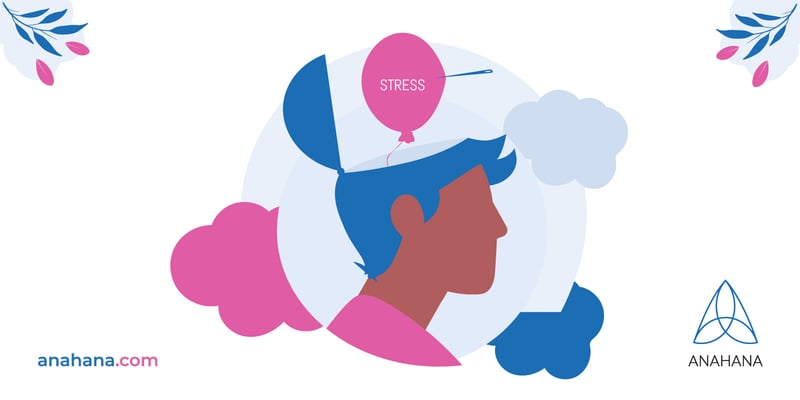
Table of Contents
Anxiety becomes concerning when its symptoms persist and intensify, significantly disrupting daily life and causing distress. Fortunately, effective treatments and practices exist that can offer support and improve well-being.
Anxiety Defined
Anxiety, a common visitor in the landscape of human emotions, often arrives unannounced, wrapped in worry, tension, or fear. Anxiety isn’t just a fleeting thought–it is a full-body experience that can cloud our minds, making even the simplest decisions feel overwhelming.
But here is the comforting truth: you are not alone in this. Though unpleasant at times, anxiety is an experience that we all share, and one that signals something needs our attention.
The Science of Anxiety
Anxiety isn’t just a feeling. It is similar to an alarm system wired into our bodies to alert us to potential threats. However, in today’s world, where dangers aren’t always as clear-cut as they used to be, our threat detection can sometimes go into overdrive, sounding the alarm at the slightest sign of trouble.
Imagine our brains having these built-in responses; when we encounter stress or perceive a threat, our bodies kick into gear with the fight-or-flight response. This triggers a cascade of reactions, such as releasing hormones like epinephrine (adrenaline), that increase heart rate and blood pressure.
These physical manifestations of anxiety–racing heart, shallow breaths–are the body’s way of preparing to confront or flee from perceived danger.
Understanding the science and physiological basis of anxiety can offer validation for our experiences. We may also feel a sense of relief, even if small, knowing that while not always helpful or needed, anxiety is our body’s way of trying to keep us safe.
Ways Anxiety Can Impact Your Daily Life
Anxiety can subtly infiltrate every corner of daily life, affecting our mental health, physical well-being, and social connections. The clouded thoughts (known as "brain fog"), tense or sore muscles, and disrupted sleep patterns that often go hand-in-hand with anxious feelings can make it difficult to focus on the things that matter to us, keep up with our social lives, and maintain a sense of balance and well-being.
“I look at it this way: the instinctive response to danger—the stress response—consists of fight, flight, or freeze. These three strategies help us survive physically, but when they’re applied to our mental and emotional functioning, we get into trouble. When there’s no enemy to defend against, we turn on ourselves. “Fight” becomes self-criticism, “flight” becomes self-isolation, and “freeze” becomes self-absorption, getting locked into our own thoughts"―Christopher K. Germer, The Mindful Path to Self-Compassion: Freeing Yourself from Destructive Thoughts and Emotions.
Anxiety vs. Anxiety Disorders: Knowing the Difference
Understanding the difference between everyday anxiety and anxiety disorders gives us insight into our inner experiences and how we can support ourselves.
Anxiety is a natural part of being human, but when it becomes persistent or overwhelming, it is important to take notice. Look for signs like:
- Regular anxiety
- Panic attacks
- Enduring distress
You might also consider making a simple anxiety scale: jot down your worries and assess their impact, from mild to severe. This helps prioritize coping strategies by identifying the most distressing sources of your anxiety while also cultivating self-awareness.
Seeking support with working through these triggers is a brave step toward finding balance and peace.
Anxiety Disorders
Anxiety disorders are among the most common mental health issues, with approximately 4% of the global population currently experiencing an anxiety disorder. Despite their prevalence, anxiety disorders often go unrecognized or untreated, leaving individuals to navigate their symptoms without help.
While effective treatments do exist, unfortunately, many people do not receive the support they need. Barriers to treatment include but are not limited to a lack of awareness about anxiety disorders and their treatability, limited investment in mental health services, and stigma around mental health issues.
Types of Anxiety Disorders
There are many types of anxiety disorders, all with different causes and triggers. The following list includes the most common conditions.
Generalized Anxiety Disorder
Generalized Anxiety Disorder (GAD) is a common mental health condition characterized by persistent and excessive worry about various aspects of life, such as work, relationships, and health, for at least six months.
Even when you know these worries might not be entirely reasonable, they stick around and are tough to shake off. People with GAD may also feel restless and tired, struggle to concentrate, get easily frustrated, feel tense in their muscles, and have trouble sleeping.
Social Anxiety Disorder
Individuals with social anxiety disorder often feel fearful or uneasy in social situations. Being around others can make them feel overly self-conscious and worried about being judged or making mistakes.
As a result, they may avoid situations that trigger these fears, which can limit their ability to lead a normal life and interact with others in a fulfilling way. Avoidance of triggers can, in many cases, perpetuate our anxiety.
Selective Mutism
Selective mutism is an uncommon issue often associated with anxiety in social settings. It causes the individual to fail to speak in social settings despite having average language skills. It is commonly seen in children and is mainly associated with extreme shyness or social anxiety. Selective mutism is often related to the diagnosis of other anxiety disorders.
Separation Anxiety Disorder
Although separation anxiety disorder is commonly associated with children, it is a misconception that it is limited to childhood; adults can also experience it. It is characterized by an intense and persistent fear of being separated from close individuals, such as a significant other or child.
Symptoms of a separation anxiety disorder include fear and distress regarding being away from home or loved ones, and can also be a symptom of codependency behaviors. It often causes these individuals to avoid being away from those they are close to; this gives them a sense of control over the anxiety.
These anxiety symptoms often stem from worrying or catastrophizing that something terrible might happen to their loved ones while away from one another.
Panic Disorder
Panic disorder is when an individual has frequent and unexpected panic attacks. A panic attack is an intense fear and discomfort when there is no immediate danger. Panic attacks commonly manifest through physical symptoms: rapid heartbeat, rapid breathing or the feeling of being unable to breathe, sweating, and uncontrolled shaking.
While there is usually no real or apparent trigger for these attacks (as in, no real threat in the present moment), they can cause a feeling of impending doom. The person with a panic disorder will often become fatigued due to the physical toll panic attacks take on the body and mind. Individuals may develop panic disorder over time or during periods of high unpredictability and stress.
What are Phobias?
In everyday life, fears are quite common, especially during childhood. However, when these fears become intense and irrational, they may indicate specific phobias, which are a part of anxiety disorders.
Specific phobias go beyond the usual reactions to things or situations, making daily life more challenging. Some people may alter their routines to avoid encountering their phobia, while others suffer through intense anxiety when confronted with it.
There are five subtypes of specific phobia:
- animal type (e.g., fear of snakes)
- natural environment type (e.g., fear of heights)
- blood-injection-injury type (e.g., fear of blood or needles)
- situational type (e.g., fear of enclosed spaces)
- other type (e.g., fear of choking)
Anxiety Risk Factors
Anxiety is a shared experience that affects many of us. Dr. Gabor Maté suggests that unresolved fears can gradually turn into long-lasting anxieties.
For those who have experienced trauma, anxiety can become a significant challenge. Triggers, sometimes subtle and unexpected, can awaken past wounds, even when the connections aren’t immediately clear.
Anxiety disorders emerge from a complex interplay of genetic and environmental factors. Stressful or traumatic events, family history, childhood adversities, substance use, and other health challenges can all contribute to its etiology.
Getting Diagnosed

When considering whether anxiety warrants professional attention, several important factors come into play:
- The level of distress caused by anxiety symptoms
- How anxiety affects daily life, including work, study, social interactions, and managing daily tasks
- The context in which anxiety arises
Seeking a proper diagnosis in line with the criteria outlined in the Diagnostic and Statistical Manual of Mental Disorders (DSM) is important as, unfortunately, many individuals endure years of suffering before finding the proper care.
Anxiety disorders often share common physical, cognitive, and behavioral traits. Diagnosis involves recognizing symptoms as excessive and unreasonable, with significant distress or impairment lasting typically six months or more.
Diagnosing anxiety disorders isn’t always straightforward. It involves matching symptoms to the appropriate disorder, each characterized by specific traits. Many people experience multiple anxiety disorders or, at the very least, meet the criteria for more conditions. Therefore, identifying and prioritizing the most distressing one is crucial to guide treatment planning.
Conventional Treatments
Treatment for anxiety disorders typically involves a combination of psychological therapies and medication. Cognitive behavioral therapy (CBT) and exposure therapy are common therapeutic approaches. CBT helps individuals recognize and challenge their thought patterns, which contribute to anxiety, while exposure therapy involves gradually confronting feared situations or objects.
Medications, such as selective serotonin reuptake inhibitors (SSRIs), are often prescribed to alleviate symptoms. It is important to consider potential side effects and interactions when choosing medication.
While psychological therapies like CBT may offer lasting benefits beyond treatment, anti-anxiety medications can provide more immediate relief. Combining therapy and medication has been associated with greater improvements in quality of life, although individual responses vary.
Self-Care
Here are gentle practices to guide you through moments of anxiety, offering solace and self-discovery along the way:
- Name your feelings: Take a moment to pause and tune into your inner world to identify and name what you're feeling; this is a form of self-acknowledgment and validation
- Practice calming techniques: Find a quiet space, take a few deep, mindful breaths, and allow yourself to be present in the moment. Practicing mindfulness or deep breathing exercises can help calm your mind and body.
- Identify patterns and triggers: Explore the patterns and triggers that contribute to your anxiety. Notice when and where your anxiety tends to arise and consider the underlying emotions at play. Understanding these patterns can help you develop strategies to work through things more effectively and with less resistance.
- Be kind to yourself: Approach your journey with compassion and curiosity. Remember that anxiety is a natural part of being human, and it's okay to feel what you feel. Embrace each emotion as an opportunity for growth and self-discovery.
If you have experienced trauma or severe distress, it is important to seek professional support and guidance. This self-care exercise is best undertaken with trained mental health professionals who can provide personalized care and support tailored to your needs.
“Another way to look at meditation is to view the process of thinking itself as a waterfall, a continual cascading of thought. In cultivating mindfulness, we are going beyond or behind our thinking, much the way you might find a vantage point in a cave or depression in the rock behind a waterfall. We still see and hear the water, but we are out of the torrent. Practicing in this way, our thought patterns change by themselves in ways that nourish integration, understanding, and compassion in our lives, but not because we are trying to make them change by replacing one thought with another one that we think may be more pure. Rather, it is to understand the nature of our thoughts as thoughts and our relationship to them, so that they can be more at our service rather than the other way round,” Jon Kabat-Zinn, Wherever You Go, There You Are
Anxiety Disorder Prognosis
Anxiety disorder prognosis brightens when treatment is sought promptly. Alongside professional treatment, embracing self-care becomes a cornerstone in managing anxiety. This involves acknowledging and naming emotions, nurturing mindfulness through practices like yoga nidra, and unraveling recurring patterns of anxiety.
By cultivating self-kindness and a steadfast commitment to personal growth, individuals can navigate the complexities of anxiety disorder with resilience and compassion.
Frequently Asked Questions
What are some effective coping strategies for anxiety?
Coping with anxiety involves finding what works best for you. Mindfulness practices, physical activity, deep breathing exercises, gratitude journaling, stress management techniques, and seeking support from loved ones or a mental health professional are all valuable tools for managing anxiety.
What role does diet play in managing anxiety?
Research suggests that embracing certain dietary practices can potentially alleviate anxiety levels. By incorporating more fruits and vegetables, along with omega-3 fatty acids, individuals may find relief from anxiety symptoms.
Additionally, adhering to "healthy" dietary patterns and exploring breakfast consumption, ketogenic diets, and micronutrient supplementation could contribute to anxiety management.
In essence, prioritizing a balanced and nutrient-rich diet holds promise for individuals seeking holistic approaches to address anxiety and enhance overall well-being.
How does exercise affect anxiety?
While exercise shows promise as a potential treatment for anxiety, conclusive evidence remains elusive due to the scarcity of data from rigorously conducted randomized controlled trials (RCTs).
While preliminary research suggests the potential benefits of exercise in managing anxiety, more robust studies are required to establish definitive conclusions about its effectiveness in alleviating symptoms.
Nonetheless, incorporating regular exercise into our routines can still offer numerous physical and mental health advantages, nurturing a sense of vitality and resilience along the way.
References
Anxiety Disorders: Types, Causes, Symptoms & Treatments
Efficacy of Treatments for Anxiety Disorders: a Meta-Analysis
Stress, Panic & Anxiety | The Survivors Trust Resources
Anxiety Disorders | World Health Organization
Disclaimer
The contents of this article are provided for informational purposes only and are not intended to substitute for professional medical advice, diagnosis, or treatment. It is always recommended to consult with a qualified healthcare provider before making any health-related changes or if you have any questions or concerns about your health. Anahana is not liable for any errors, omissions, or consequences that may occur from the use of the information provided.

By: Anahana
The Anahana team of researchers, writers, topic experts, and computer scientists come together worldwide to create educational and practical wellbeing articles, courses, and technology. Experienced professionals in mental and physical health, meditation, yoga, pilates, and many other fields collaborate to make complex topics easy to understand.
